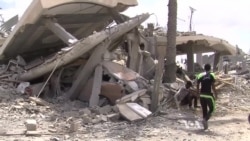Hundreds of Gazans returned to their homes Monday during a seven-hour humanitarian ceasefire declared by Israel.
For those returning to one of the hardest-hit neighborhoods — an agricultural area in Khan Younis, several hundred meters from Gaza’s boundary with Israel — only more devastation was there to greet them.
Ahmed, who gave only his first name, was making his first trip back since Israeli ground operations began more than two weeks ago.
"It was three stories high," he says, showing where his family home once stood. "Now there is nothing.
“This is the first time that our building is destroyed. We don’t even know why. Every time there is a war, [Israel] just destroys our houses," he adds. "It’s just simple people living here. They don’t have any ties to militants.”
Israel launched its offensive in Gaza four weeks ago to destroy infiltration tunnels and rocket sites that Hamas-led militants use to attack Israelis.
Khan Younis was one of the most heavily hit areas.
An estimated 200,000 displaced Gazans have moved in with family members in other parts of Gaza. One-quarter million have taken shelter in United Nations facilities such as schools — some of which have been hit by Israeli airstrikes — while others camp out on the streets.
Some hope to return to their homes when the fighting dies down, but not everyone can. Om Omar al-Najar, a Khan Younis resident whose family owns a farm near the border, says their home was damaged beyond repair and all its furnishings burned.
Her family will return to rebuild, she says, but it won't be the first time.
“They bombarded the neighborhood before and we came back and re-built it, and we will do it again. We will do it every time they destroy it because we have no other land. We will never let Israelis take our land.”
The future for the homeless is uncertain, and housing them will be only a part of the massive relief effort that will be needed in Gaza when the fighting ends.











